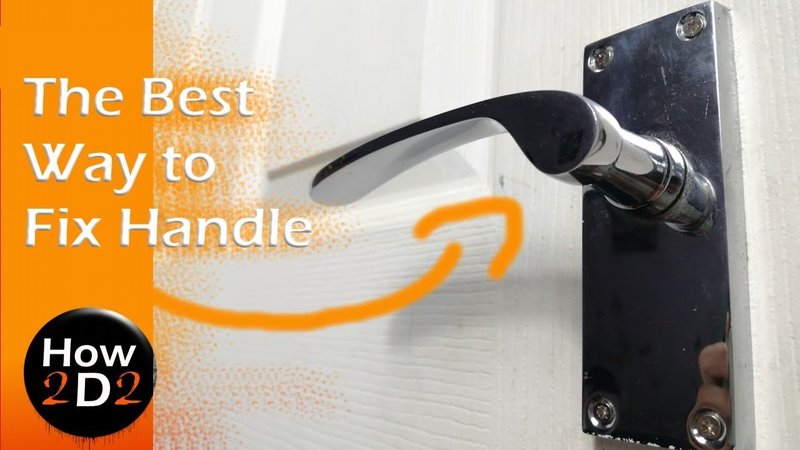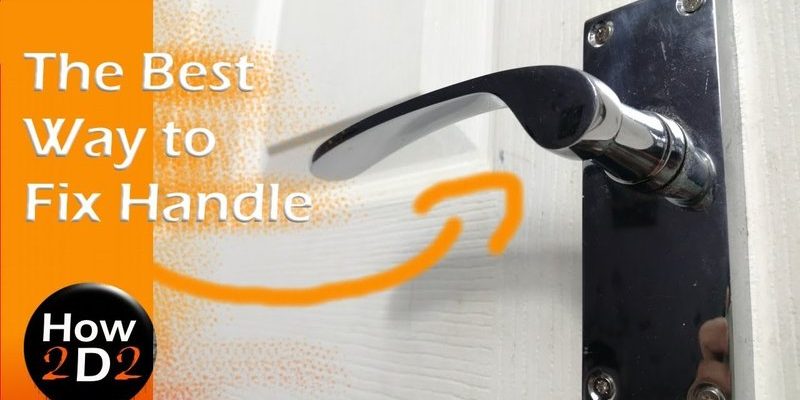
Here’s the thing: troubleshooting a loose handleset on a textured fiberglass door isn’t rocket science, but there are a few quirks to watch out for. Fiberglass doors are tough but not invincible, especially the beautifully textured ones from brands like Therma-Tru or JELD-WEN. The texture, the material, and the way handlesets connect all play a role in both why things go loose and how you fix them without making things worse. Let me walk you through how to get a snug, safe fit again—without scratching your door or driving yourself crazy.
Why Handlesets Loosen on Textured Fiberglass Doors
Honestly, nobody plans for a handleset to loosen up, but it happens more than you’d think—especially on textured fiberglass doors. That rougher, wood-grain finish looks great, but it can hide a few headaches. As you use the door daily, little movements and temperature changes can slowly undo even the tightest screws. Over time, the handleset starts to feel off.
Most handlesets attach using screws or through-bolts that sandwich your door between interior and exterior hardware. If those screws aren’t perfectly flush against the door’s surface—easy to miss with a bumpy, textured fiberglass slab—they can wiggle loose. The texture creates tiny gaps, so even if you tightened everything last year, movement and vibration work them loose again.
Another thing to keep in mind is that fiberglass flexes differently than wood or steel. Bumps, slams, or even a strong wind can flex the panel just enough to shift the hardware. It’s like the difference between standing on a trampoline versus a hardwood floor. That movement can stress the handleset, causing screws to back out or the latch plate to shift. So, if your front door sees a lot of use, loosening is almost expected unless it’s installed and maintained with a bit more care.
Inspecting Your Handleset and Door Before Tightening
You might be tempted to grab a screwdriver and just start turning, but let’s slow down. First, it’s important to check what you’re actually dealing with on your textured fiberglass door. Some brands, like Schlage or Kwikset, have visible screws on the inside plate, while others hide them under a decorative cover. Grab a flashlight and examine both sides of the handleset—look for obvious gaps, loose screws, or chipped paint around the fixture.
Pay close attention to the way the handleset sits against the door. Does it tilt? Is there a bigger gap at the top or bottom? Sometimes, the handle itself is firm, but the deadbolt or thumb latch is the real trouble spot. Also, check around the keyhole. If the texture seems squashed or the hardware doesn’t sit evenly, it’s a clue that the handle wasn’t installed flush to begin with.
Before diving in with tools, check if the screws are stripped or if there’s damage to the fiberglass. Use your hands to gently wiggle the handleset. Listen for rattling inside—sometimes the connecting bar (the “spindle”) can be loose too. Snap a quick photo for reference if you’re worried you won’t remember how things go back together. Trust me, it’s better to be safe than stuck with a puzzle you can’t reassemble.
Gathering the Right Tools and Materials
Having the right tools ready makes this whole troubleshooting process worlds easier. You’ll want a reliable Phillips-head screwdriver for most handlesets, but sometimes you’ll need a flathead or even a small Allen wrench, depending on your brand. If your handleset has hidden screws under a decorative plate, a small utility knife or plastic pry tool helps pop off the cover without scratching your textured fiberglass.
Here are a few other supplies to keep handy:
- Threadlocker: A tiny dab on screw threads can keep things tight longer, especially in homes with lots of vibration.
- Soft cloth: To wipe away dust or grime around the hardware before reseating it.
- Wooden toothpicks or matchsticks: Handy for filling out stripped screw holes. Even though it’s a fiberglass door, some handlesets use wood reinforcement or inserts.
- Level: To double-check your handleset sits straight—textured fiberglass can make things look “off” even when they aren’t.
Don’t forget a small tray or cup to hold screws. Tiny hardware has a magical way of vanishing when you set it down “just for a second.” If your handleset comes with a mounting template or code for instructions, keep that nearby as well. You don’t want to lose a special reset pin or pairing tool if you’re dealing with a “smart” lock upgrade.
How to Tighten a Loose Handleset on a Textured Fiberglass Door
Once you’ve checked everything and gathered your tools, it’s time to actually tighten that loose handleset. Let’s break it down into clear steps:
- Remove the interior cover plate. If your handleset has a decorative plate hiding the screws, gently pop it off. Use your fingers or a plastic tool to avoid scratching the texture of your fiberglass door.
- Find and tighten all mounting screws. Using the right screwdriver, snug each screw in small increments. Don’t over-tighten—you want it firm, not cracked or stripped. If a screw keeps turning, the hole might be stripped (more on that in the next section).
- Check the exterior plate and handleset. Hold the outside piece still while tightening the inside. This helps everything seat flush, especially on textured fiberglass where things can shift around.
- Test the handle and lock function. Open and close the door, turn the handle, and lock/unlock. It should feel solid and smooth, not sticky or loose.
If you need to, apply a tiny drop of threadlocker to the screws before tightening. This extra “grip” can keep things secure even if your door gets a lot of slamming or shaking. If your set has a reset or pairing button for an electronic lock, make sure you haven’t accidentally nudged any wires or batteries out of place when working on the assembly.
What to Do If the Screw Holes Are Stripped or Damaged
You’ve tightened every screw, but the handleset still wiggles. That’s a sign the screw holes inside your textured fiberglass door might be stripped or worn out. It happens, especially if a previous owner tried to “fix” it with brute force. Here’s how to handle it without calling in a pro (yet):
If your handleset is mounted to wood inserts or blocking inside the fiberglass, try this:
- Remove the screw and pack the hole with a couple of wooden toothpicks (break them to fit).
- Add a drop of wood glue if you want extra strength, then reinsert the screw while the glue’s wet.
- Let it dry before using the handle again.
If you’re dealing with full fiberglass (no wood reinforcement):
- Pick up a handleset mounting kit from the hardware store. These often come with slightly larger screws or expansion anchors designed for fiberglass doors.
- Follow the instructions for installing the anchor, then drive the new screw in gently.
If the damage is severe, or if the hardware just won’t hold, don’t keep forcing it. A door specialist can repair or replace the internal blocking without replacing the whole slab. Sometimes you need a reset, not a full replacement.
Protecting Your Textured Fiberglass Door from Future Loosening
After you’ve fixed a loose handleset, you want to keep things tight for the long haul. Here’s what I’ve learned the hard way: prevention’s a lot easier (and cheaper) than repairs. Start by checking the handle every few months. Just give it a quick wiggle when you walk by. If you catch a tiny bit of movement early, all it usually takes is a quick tighten.
Try not to slam the door—easier said than done, especially if you’ve got kids or a dog that likes dramatic exits. If your home shakes a lot from nearby traffic or wind, it’s worth using threadlocker on the screws and checking the strike plate, too.
For painted or stained textured fiberglass, take care when cleaning around the handleset. Harsh chemicals can weaken the finish and eventually loosen the grip the handleset has on the door. Use a soft cloth and mild cleaner so you don’t wear down the texture or let water seep behind the hardware. If you ever remove the handleset entirely (for painting, for example), always double-check alignment and use the right code or template for reinstalling.
When to Call a Pro or Consider Replacement
Most of the time, tightening a loose handleset on a textured fiberglass door is a solid DIY fix. But there are times—honestly—when it’s smarter to call in a pro. If you find cracks around the mounting holes, deep gouges in the fiberglass, or if the handleset just won’t anchor no matter what you try, a door specialist can make repairs you might not have tools for.
If you’re thinking about upgrading from a standard key handleset to a smart lock or keypad system, check that it’s compatible with your specific fiberglass door and texture. Sometimes, universal or “brand” remotes and smart locks require a different installation method. Some need a reset or sync process when you install, especially if there’s a battery or code pairing step. If you’re ever unsure, getting professional advice can save both your time and your door’s good looks.
Ultimately, a secure, well-fitted handleset is your door’s handshake to the world. Keeping it snug means easier entry, a safer home, and a lot less daily frustration—no matter how often you come and go.
Final Thoughts on Troubleshooting a Loose Handleset
Fixing a loose handleset on your textured fiberglass door isn’t just about tightening a screw. It’s about giving your entryway the sturdy, welcoming feel it deserves. By taking a few minutes to inspect, use the right tools, and protect your hardware, you save yourself bigger headaches down the road. Sure, it takes a little patience and a careful touch—especially on textured doors from names like Therma-Tru and JELD-WEN—but the peace of mind is worth it.
So next time your door handle feels wobbly, don’t ignore it or put off the fix. With these steps, you’ll have things secure again quickly, and your textured fiberglass door will keep looking sharp—and working just right—for years to come.
